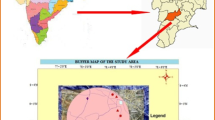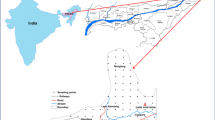Abstract
The spatial distribution of soil physicochemical characteristics and four heavy metals (Mn, Fe, Zn, and Cu) in the semi-arid climatic region of Neyshabur plain in Northeast of Iran was investigated and identified soil pollution hotspots zone using Moran’s I and GIS techniques. The geostatistical techniques, Pearson’s correlation matrix, and spatial autocorrelation were used to locate the pollution sources and concentration. Geostatistical interpolation techniques determined the spatial distribution of heavy metals. The mean values of Iron (Fe), Manganese (Mn), Zink (Zn), Copper (Cu) were 2.31, 7.18, 2.84, 1.16 mg/kg, respectively. The routs comes of the spatial statistical method have established the gravity of pollutions and their anthropogenic impact based on spatial changes in contamination levels. The genesis of the pollution process was influenced by natural factors (e.g., the high soil shale, the sandstone, the calcareous and the metamorphic parents and the background values) as well as by anthropogenic factors (e.g., waste disposal, extraction from mines of distinct mineral ores and high, unmanaged practices of fertilizer). Although nearly all the monitoring classes of land use suffered from contamination by heavy metals, farmland was the most contaminated. This evidence will help land use planners and environmental menace administrators to promote environmentally sound economic expansion policies.
Access this chapter
Tax calculation will be finalised at checkout
Purchases are for personal use only
Similar content being viewed by others
References
Andersson H, Bergström L, Ulén B, Djodjic F, Kirchmann H (2015) The role of subsoil as a source or sink forphosphorus leaching. J Environ Qual 44:535–544
Anselin L (1995) Local indicators of spatial association-LISA. Geogr Anal 27(2):93–115
Atafar Z, Mesdaghinia AR, Nouri J, Homaee M, Yunesian M, Ahmadimoghaddam M, Mahvi AH (2010) Effect of fertilizer application on soil heavy metal concentration. Environ Monit Assess 160(1–4):83–89
Bagherzadeh A, Ghadiri E, Darban ARS, Gholizadeh A (2016) Land suitability modeling by parametric-based neural networks and fuzzy methods for soybean production in a semi-arid region. Model Earth Syst Environ 2(2):104
Bhattacharya A, Routh J, Jacks G, Bhattacharya P, Mörth M (2006) Environmental assessment of abandoned mine tailings in Adak,Västerbotten district (northern Sweden). Appl Geochem 21:1760–1780
Dhaliwal SS, Naresh RK, Mandal A, Singh R, Dhaliwal MK (2019) Dynamics and transformations of micronutrients in agricultural soils as influenced by organic matter build-up: a review. Environ Sustain Indicators 1–2:100007
Doabi SA, Karami M, Afyuni M, Yeganeh M (2018) Pollution and health risk assessment of heavy metals in agricultural soil, atmospheric dust and major food crops in Kermanshah province, Iran. Ecotoxicol Environ Saf 163:153–164
Doabi S, Karami M, Afyuni M (2019) Heavy metal pollution assessment in agricultural soils of Kermanshah province, Iran. Environ Earth Sci 78:70
Gee GW, Bauder JW (1986) Methods of soil analysis: part 1. Agronomy handbook 9. In: Klute A (ed) Particle size analysis. American Society of Agronomy and Soil Science Society of America, Madison (WI), pp 383–411
Gribov A, Krivoruchko K (2004) Geostatistical mapping with continuous moving neighbourhood. Math Geol 36(2)
Heidari A, Kumar V, Keshavarzi A (2019) Appraisal of metallic pollution and ecological risks in agricultural soils of Alborz province, Iran, employing contamination indices and multivariate statistical analyses. Int J Environ Health Res 1–19
Hou D, O’Connor D, Nathanail P, Tian L, Ma Y (2017) Integrated GIS and multivariate statistical analysis forregional scale assessment of heavy metal soil contamination: a critical review. Environ Pollut 231:1188–1200
Hoyle FC, Antuono MD, Overheu T, Murphy DV (2013) Capacity for increasing soil organic carbon stocks in dryland agricultural systems. Soil Res 51:657–667
Huang S-W, Jin J-Y (2008) Status of heavy metals in agricultural soils as affected by different patterns of land use. Environ Monit Assess 139(1–3):317–327. https://doi.org/10.1007/s10661-007-9838-4
Jossart J, Theuerkauf SJ, Wickliffe LC, Morris Jr. JA (2020) Applications of spatial autocorrelation analyses for marine aquaculture siting. Front Mar Sci. https://doi.org/10.3389/fmars.2019.00806
Kabata-Pendias A (2011) Trace elements in soils and plants. CRC Press, Boca Raton, FL, USA
Khamesi A, Khademi H, Zeraatpisheh M (2020) Biomagnetic monitoring of atmospheric heavy metal pollution using pine needles: the case study of Isfahan, Iran. Environ Sci Pollut Res 27:31555–31566. https://doi.org/10.1007/s11356-020-09247-5
Krami LK, Amiri F, Sefiyanian A, Shariff AR, Tabatabaie T, Pradhan B (2013) Spatial patterns of heavy metals in soil under different geological structures and land uses for assessing metal enrichments. Environ Monit Assess 185(12):9871–9888. https://doi.org/10.1007/s10661-013-3298-9
Li J, Heap AD (2014) Spatial interpolation methods applied in the environmental sciences: a review. Environ Model Softw 53:173–189
Lu X, Wang L, Li LY, Lei K, Huang L, Kang D (2010) Multivariate statistical analysis of heavy metals instreet dust of Baoji, NW China. J Hazard Mater 173:744–749
Moghtaderi T, Mahmoudi S, Shakeri A, Masihabadi MH (2018) Heavy metals contamination and human health risk assessment in soils of an industrial area, Bandar Abbas-South Central Iran. Hum Ecol Risk Assess 24:1058–1073
Moghtaderi T, Mahmodi S, Shakeri A, Masihabadi MH (2019) Contamination evaluation, health and ecological risk index assessment of potential toxic elements in the surface soils (case study: Central Part of Bandar Abbas County). J Soil Water Conserv 8:51–65
Oenema O, Witzke HP, Klimont Z, Lesschen JP, Velthof GL (2009) Integrated assessment of promising measures to decrease nitrogen losses from agriculture in EU-27. Agric Ecosyst Environ 133:280–288
Okrent D (1999) On intergenerational equity and its clash with intragenerational equity and on the need for policies to guide the regulation of disposal of wastes and other activities posing very long time risks. Risk Anal 19:877–901
Olsen SR, Cole CV, Watanabe FS, Dean LA (1954) Estimation of available phosphorus in soils by extraction with sodium bicarbonate. Government Printing Office, Washington. D.C
Parizanganeh A, Hajisoltani P, Zamani A (2010) Assessment of heavy metal pollution in surficial soils surrounding zinc industrial complex in Zanjan-Iran. International society for environmental information sciences 2010 annual conference (ISEIS). Procedia Environ Sci 2:162–166
Ravankhah N, Mirzaei R, Masoum S (2016) Spatial eco-risk assessment of heavy metals in the surface soils ofindustrial city of Aran-o-Bidgol, Iran. Bull Environ Contam Toxicol 96:516–523
Reghunath R, Murthy TRS, Raghavan BR (2002) The utility of multivariate statistical techniques in hydrogeochemical studies: an example from Karnataka, India. Water Res 36:2437–2442
Ren B, Chen Y, Zhu G, Wang Z, Zheng X (2016) Spatial variability and distribution of the metals in surfacerunoff in a nonferrous metal mine. J Anal Methods Chem 2016:4515673
Rengel Z (2002) Agronomic approaches to increasing zinc concentration in staple food crops. In: Cakmak I, Welch RM (eds) Impacts of agriculture on human health and nutrition. UNESCO, EOLSS Publishers, Oxford, UK
Richardson GM, Bright DA, Dodd M (2006) Do current standards of practice in Canada measure what is relevant to human exposure at contaminated sites? II: oral bio-accessibility of contaminants in soil. Hum Ecol Risk Assess 12:606–618
Rodrigo-Comino J, Keshavarzi A, Zeraatpisheh M, Gyasi-Agyei Y, Cerdà A (2019) Determining the best ISUM (Improved stock unearthing Method) sampling point number to model long-term soil transport and micro-topographical changes in vineyards. Comput Electron Agric 159:147–156. https://doi.org/10.1016/j.compag.2019.03.007
Santos-Francés F, Martínez-Graña A, Zarza CÁ, Sánchez AG, Rojo PA (2017) Spatial distribution of heavymetals and the environmental quality of soil in the Northern Plateau of Spain by geostatistical methods. Int J Environ Res Public Health 14:568
Simeonov V, Simeonova P, Tzimou-Tsitouridou R (2004) Chemometric quelity assessment of surface waters: two case studies. Chem Eng Ecol 11:449–469
Soffianian A, Bakir HB, Khodakarami L (2015) Evaluation of heavy metals concentration in soil using GIS, RS and geostatistics. IOSR J Environ Sci Toxicol Food Technol 9(12):61–72
Soffianian A, Madani ES, Arabi M (2014) Risk assessment of heavy metal soil pollution through principal components analysis and false color composition in Hamadan Province, Iran. Environ Syst Res 3:3. https://doi.org/10.1186/2193-2697-3-3
Sungur A, Soylak M, Ozcan H (2014) Investigation of heavymetal mobility and availability by the BCR sequential extraction procedure: relationship between soilproperties and heavy metals availability. Chem Speciation Bioavail 26(4):219–230. https://doi.org/10.3184/095422914X14147781158674
Thomas GW (1996) Methods of soil analysis: part 2. Agronomy handbook 9. In: Page AL (ed) Soil pH and soil acidity. American Society of Agronomy and Soil Science Society of America, Madison (WI), pp 475–490
Urzelai A, Vega M, Angulo E (2000) Deriving ecological risk-based soil quality values in the Basque Country. Sci Total Environ 247:279–284
Walkley A, Black IA (1934) An examination of the Degtjareff method for determining soil organic matter and a proposed modification of the chromic acid titration method. Soil Sci 37:29–38
Wang G, Zhang S, Xiao L, Zhong Q, Li L, Xu G, Deng O, Pu Y (2017) Heavy metals in soils from a typicalindustrial area in Sichuan, China: Spatial distribution, source identification, and ecological risk assessment. Environ Sci Pollut Res 24:16618–16630
Xiao R, Bai J, Huang L, Zhang H, Cui B, Liu X (2013) Distribution and pollution, toxicity and risk assessment of heavy metals in sediments from urban and rural rivers of the Pearl River delta in southern China. Ecotoxicology 22(10):1564–1575
Yan X (2009) Linear regression analysis: theory and computing. Published by World Scientific Publishing Co. Pte. Ltd. 5 Toh Tuck Link, Singapore 596224
Zhang LM, Liu YL, Li XD, Huang LB, Yu DS, Shi XZ et al (2018) Effects of soil map scales on simulating soil organic carbon changes of upland soils in eastern China. Geoderma 312:159–169
Zhong L, Liu L, Yang J (2012) Characterization of heavy metal pollution in the paddy soils of Xiangyin County, Dongting lake drainage basin, central south China. Environ Earth Sci. https://doi.org/10.1007/s12665-012-1671-6
Disclosure Statement
No potential conflict of interest was reported by the author(s).
Author information
Authors and Affiliations
Corresponding author
Editor information
Editors and Affiliations
Rights and permissions
Copyright information
© 2022 The Author(s), under exclusive license to Springer Nature Switzerland AG
About this chapter
Cite this chapter
Keshavarzi, A., Bhunia, G.S., Shit, P.K., Ertunç, G., Zeraatpisheh, M. (2022). Spatial Pattern Analysis and Identifying Soil Pollution Hotspots Using Local Moran's I and GIS at a Regional Scale in Northeast of Iran. In: Shit, P.K., Adhikary, P.P., Bhunia, G.S., Sengupta, D. (eds) Soil Health and Environmental Sustainability. Environmental Science and Engineering. Springer, Cham. https://doi.org/10.1007/978-3-031-09270-1_12
Download citation
DOI: https://doi.org/10.1007/978-3-031-09270-1_12
Published:
Publisher Name: Springer, Cham
Print ISBN: 978-3-031-09269-5
Online ISBN: 978-3-031-09270-1
eBook Packages: Earth and Environmental ScienceEarth and Environmental Science (R0)




